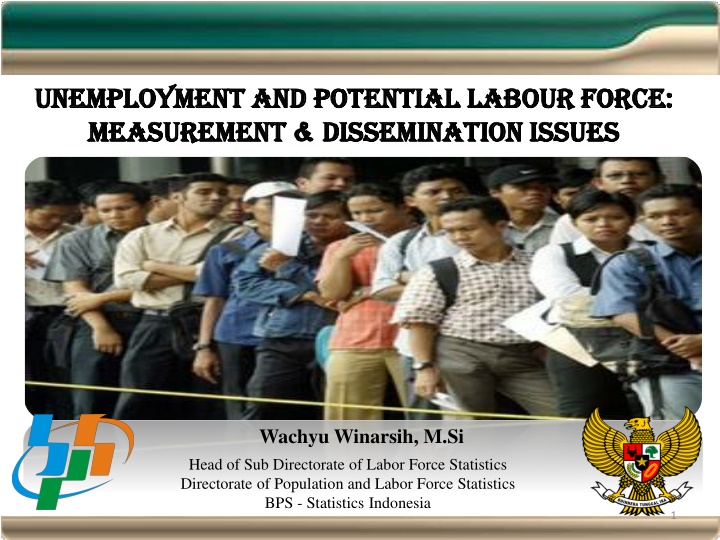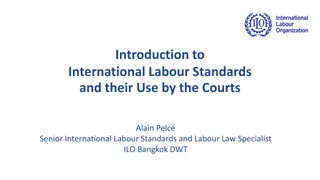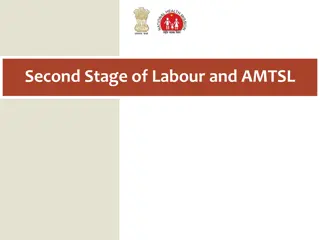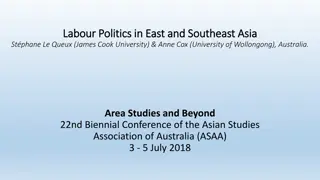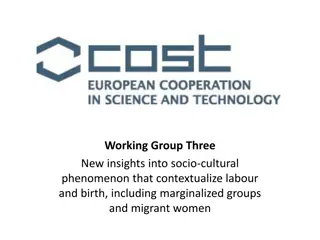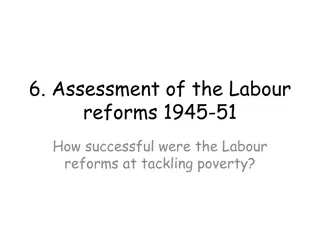Labour Force Statistics
This content delves into the measurement and dissemination issues surrounding unemployment, potential unemployment, and labor force statistics as per BPS - Statistics Indonesia. It covers various aspects such as labor underutilization, classification of labor force status, components of labor force, and definitions of unemployment. The content emphasizes the importance of monitoring labor markets and highlights the need to address the unmet need for employment in the population.
Download Presentation

Please find below an Image/Link to download the presentation.
The content on the website is provided AS IS for your information and personal use only. It may not be sold, licensed, or shared on other websites without obtaining consent from the author.If you encounter any issues during the download, it is possible that the publisher has removed the file from their server.
You are allowed to download the files provided on this website for personal or commercial use, subject to the condition that they are used lawfully. All files are the property of their respective owners.
The content on the website is provided AS IS for your information and personal use only. It may not be sold, licensed, or shared on other websites without obtaining consent from the author.
E N D
Presentation Transcript
Unemployment and Potential Unemployment and Potential labour Measurement & dissemination issues Measurement & dissemination issues labour force: force: Wachyu Winarsih, M.Si Head of Sub Directorate of Labor Force Statistics Directorate of Population and Labor Force Statistics BPS - Statistics Indonesia 1
BPS - Statistics Indonesia Contents Unemployment Potential labour force Measurement in labour force surveys Measures of labour underutilization and related dissemination issues 2
BPS - Statistics Indonesia Recall: Labour underutilization: Scope Refers to mismatches between labour supply and demand, which translate into an unmet need for employment among the population Para 40,Resol I. (19th ICLS, 2013) In reference to employment (work for pay or profit) Identifies groups among the employed & persons outside the labour force who share similarities with the unemployed Focuses on issues of insufficient labour absorption For broader labour market monitoring 3
BPS - Statistics Indonesia Labour underutilization: 3 main components Working age population Labour force Outside the labour force Employed (for pay/profit) Labour market attachment Unemployed Potential Labour Force -seeking, not available -available, not seeking Time-related underemployed Want employment but not seeking, not available Do not want employment Labour underutilization (unmet need for employment) 4
BPS - Statistics Indonesia Labour force status classification Activity principle + priority rule + 1 hr. criterion Working age population (a + b + c) In short reference period, worked for pay / profit for 1+ hours Y N NOT EMPLOYED (without work for pay/ profit) Seeking work for pay/profit With job for pay / profit, not at work N Y N Available Y Y N a. Employed b. Unemployed Labour force (a + b) c. Outside the labour force 5 ILO Department of Statistics ILO Department of Statistics 5 5
BPS - Statistics Indonesia Unemployment Definition Reference periods Methods of job search Special cases 6
BPS - Statistics Indonesia Unemployment: Scope Indicator of current unused supply of labour Different from beneficiaries of unemployment insurance Emphasis on monitoring labour markets Captures persons without employment, putting pressure on labour market Signals situations of potential match between available labour supply (people) and available demand (jobs) May be engaged in other activities, or receive government benefits Unemployed housewife, unemployed student, unemployed subsistence farmer, unemployed pensioner Measured only through household surveys Need to establish person s job search and availability 7
BPS - Statistics Indonesia Unemployed persons : Operational definition Working age persons who were: 1. Not employed in last 7 days / reference week 2. Carried out activities to seek employment in last 4 weeks / reference month 3. Available to start job/business In reference week OR In short subsequent period (up to 2 weeks) Highlights potential matches between available labour supply (people) and available demand (jobs) at a given point in time Must fulfil ALL three criteria to be classified as unemployed 8
BPS - Statistics Indonesia Unemployment: Reference periods To capture unemployment among different groups usually engaged in other activities (women, rural areas) 9
BPS - Statistics Indonesia Availability reference period: Optional extension As per sensitivity tests To reduce differences across groups due to social/contextual factors Unemployment rate under different reference periods for availability , Madagascar 2010. In ref. week 6,0 % 5,8 % 5,9 % One week after 6,6 % 7,0 % 6,8 % One month after 6,6 % 7,0 % 6,8 % Men Women Total Previous standards No change after month Rise 10
BPS - Statistics Indonesia Job search activities Must create an opportunity for a job match Examples of active search methods (when to find a job opportunity): Arranging for financial resources, applying for permits Looking for land, premises, machinery, supplies, Seeking assistance from friends, family, other intermediaries Registering with or contacting public or private employment services Applying to employers directly, checking at worksites, farms, factory gates, markets, etc Placing / applying to newspaper or online job ads Placing / updating resumes on professional sites online 11
BPS - Statistics Indonesia Special cases: Unemployed or Not? 1. Persons with job offer to start in the future Unemployed only if they are currently available to work 2. Persons on indefinite layoff Not unemployed, they must seek work and be available 3. Persons waiting results of a job application Not unemployed, they must seek work and be available 4. Persons reading the job advertisement section of newspaper Not unemployed, they must apply to a job and be available 12
BPS - Statistics Indonesia Potential labour force Operational definition Components Discouraged job seekers 13
BPS - Statistics Indonesia Potential labour force Sub-group of persons outside the labour force With expressed interest in employment Relevant in contexts with Limited labour market, job opportunities Limited channels to seek employment Relevant for groups With other responsibilities (women, students) Environment limits their capacity to seek / be available for work 14
BPS - Statistics Indonesia Persons outside the labour force 3 alternative classifications By labour market attachment Essential to identify potential labour force Do they express interest in employment? By main reason for not being in the labour market Why are they not engaged in the labour market? By main activity What is their main situation? 15
BPS - Statistics Indonesia Population outside labour force by labour market attachment 1. Seeking employment, but not available 2. Not seeking employment, but want and available to work Labour market attachment Discouraged 3. Not seeking, Not available but want employment 4. Does not want employment Based on SAME questions used to identify the unemployed 16
BPS - Statistics Indonesia Classification of POLF by labour market attachment Working age population Labour force Outside the labour force Employed (for pay/profit) Unemployed -seeking, not available -not seeking but want and available not seeking, not available but Want employment Do not want employment 17
BPS - Statistics Indonesia Potential labour force Unavailable job seekers 1. Seeking employment, but not available 2. Not seeking employment, but want and available to work Available non-job seekers Discouraged 3. Not seeking, Not available but want employment 4. Does not want employment Comprises two sub-groups of persons outside the labour force Unavailable job seekers Available, but not seeking employment 18 18 ILO Department of Statistics
BPS - Statistics Indonesia Discouraged job seekers Sub-group of potential labour force Identified by cross-classification of population outside labour force by Labour market attachment Reasons for not being in labour market Definition Working age persons, not in employment, who were Not seeking employment due to labour market reasons But available and wanting employment 19
BPS - Statistics Indonesia Classification by Main reason for not being in labour market Personal reasons Own illness, disability Studies, training Family related reasons Pregnancy, family or household responsibilities Refusal by family Labour market reasons Past failure in finding a job, gave up looking for jobs Lack of experience, qualifications or jobs matching skills Lack of jobs in the area Considered too young or too old by prospective employers Lack of infrastructure No roads, transport, employment services in the area Other sources of income Pensions, rents Serves to identify discouraged job seekers 20
BPS - Statistics Indonesia Measurement in labour force surveys Basic survey structure Essential question flow Question formulation 21
BPS - Statistics Indonesia Identification in labour force surveys 0+ Module I: Household Roster & Demographic Characteristics Module II: Education & training Module III: Participation in the Labour Market -Identification of persons in employment Y n+ W A P N Persons in employment Persons NOT in employment -Characteristics of main job -Characteristics of other jobs -Job search & availability -Previous employment experience Module IV: Participation in Own use production of goods Optional Work modules: -Unpaid trainee work -Volunteer work -Provision of services for own final use 22
BPS - Statistics Indonesia Implementation issues Emphasis on active job search Sequence should start with question on job search Methods of job search serve as test of active search Questions should be appropriate for all types of jobs Search for self-employment jobs and paid employment, part-time work, paid apprentice type work, etc. Requires new question on desire to work for pay or profit Asked only to persons who did not carry out job search activities Availability serves to determine readiness in terms of time Should be asked to all persons who seek or want to work for pay or profit Question should clarify this (i.e. how soon can person start working) Includes availability to work part-time or full-time 23
BPS - Statistics Indonesia WORKING AGE POPULATION Worked for pay / profit for 1+ hours Y NOT EMPLOYED (without work for pay/ profit) N N With job, not at work Seeking work for pay/profit Y Job search method Y N Reason of absence Want work Duration Duration of search Y N 3 mo. >3 mo. Char. Job sought Reason not seeking N Pay Y Available Available Y N Y N Reason / Situation U E Labour force Willing Potential LF Others Outside labour force 24 24 ILO Department of Statistics
BPS - Statistics Indonesia Identification in labour force surveys Employed in last week? No Unemployed Looked for work in last 4 weeks? YES YES No Is currently available to work? Wants work for pay / profit YES No Is currently available to work? Potential labour force YES 25 ILO Department of Statistics 25
BPS - Statistics Indonesia Sample questions (I): Active job search 26
BPS - Statistics Indonesia Sample questions (II): Duration of job search Comprises the period from when the person last stop working or when started seeking work up to the interview date, whichever is the shortest For future starters, it ends when the person got the job/business opportunity Serves to identify persons in long-term unemployment, defined as: Unemployed persons who have been without work and seeking work for 12 months or more 27 27 ILO Department of Statistics
BPS - Statistics Indonesia Sample questions (III) Desire, Reasons & Availability 28
BPS - Statistics Indonesia Measures of labour underutilization and related dissemination issues Tabulations Classifications for analysis Reporting documentation International reporting 29
BPS - Statistics Indonesia NEW Measures of labour underutilization (LU1-LU4) LU4 30 30
BPS - Statistics Indonesia Indicators of labour underutilization Four indicators: to assess the nature of LU throughout the business cycle: LU1: Unemployment rate: [persons in unemployment / labour force] x 100 Note: extended LF = LF + potential labour force LU2: Combined rate of time-related underemployment and unemployment: [(persons in time-related underemployment + persons in unemployment) / labour force] x 100 LU3: Combined rate of unemployment and potential labour force: 3 [(persons in unemployment + potential labour force) / (extended labour force)] x 100 LU4: Composite measure of labour underutilization: [(persons in time-related underemployment + persons in unemployment + potential labour force) / (extended labour force)] x 100 31
BPS - Statistics Indonesia Tabulations Statistics should be tabulated by sex, specified age groups, level of educational attainment and by region, including urban and rural areas. For descriptive analysis of the labour market, tabulations should be produced on: (a) working-age population by labour force status (including unemployment) and category of labour underutilization; and transitions (gross flows) between statuses, where possible; (b) persons in unemployment or outside the labour force by characteristics of their current or last main job, e.g. industry, occupation, status in employment, type of economic unit (formal market units/informal market units/non-market units/households), institutional sector, geographic location of place of work, type of remuneration, specified bands of employment-related income and specified working- time hour bands, according to the relevant international statistical standards; (c) persons in unemployment by duration intervals of search for employment that permit separate identification of persons in long-term unemployment. 32
BPS - Statistics Indonesia Classifications for analysis of POLF (1) Classifications may be used to study subgroups of persons outside the labour force, e.g. those affected by discouragement or by gender- based, economic or social barriers to employment: Degree of labour market attachment : (i) persons seeking employment but not currently available (ii) persons not seeking employment but currently available (iii) persons neither seeking employment nor currently available but who want employment (iv) persons neither seeking employment nor currently available who do not want employment 33
BPS - Statistics Indonesia Classifications for analysis of POLF (2) Main reason for not seeking employment , not being currently available or not wanting employment: personal reasons (own illness, disability, studies) family-related reasons (pregnancy, presence of small children, refusal by family) labour market reasons (past failure to find a suitable job, lack of experience, qualifications or jobs matching the person s skills, lack of jobs in the area, considered too young or too old by prospective employers) lack of infrastructure (assets, roads, transportation, employment services) other sources of income (pensions, rents) social exclusion 34
BPS - Statistics Indonesia Reporting documentation To enhance transparency, statistics should be reported with regard to: scope and coverage concepts and definitions any estimation or adjustment methods, including seasonal adjustments or imputation procedures where possible, measures of data quality and precision, e.g., relative standard errors that account for complex survey designs Revisions, new time series or indicators should be adequately indicated and documented, e.g. publication of dual estimates or series, for at least one year, following their implementation. 35
BPS - Statistics Indonesia International reporting Labour underutilization Countries are encouraged to report headline indicators of labour underutilization (from among LU1, LU2, LU3 and LU4) for the population as a whole by sex by urban/rural areas by levels of educational attainment by standard age ranges 36
BPS - Statistics Indonesia References: 37
Thank you Thank you 38
